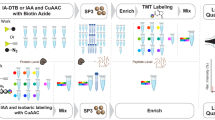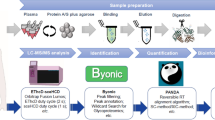Abstract
C-reactive protein (CRP) is a major human acute-phase reactant that is composed of five identical subunits. CRP dissociates into subunits at inflammatory loci forming monomeric CRP (mCRP) with substantially enhanced activities, which can be further activated by reducing the intra-subunit disulfide bond. However, conformational changes underlying the activation process of CRP are less well understood. Conformational changes accompanying the conversion of CRP to mCRP with or without reduction were examined with circular dichroism spectroscopy, fluorescence spectroscopy, electron microscopy, size-exclusion chromatography, and neoepitope expression. The conversion of CRP to mCRP follows a two-stage process. In the first stage, CRP dissociates into molten globular subunits characterized by intact secondary structure elements with greatly impaired tertiary packing. In the second stage, these intermediates completely lose their native subunit conformation and assemble into high-order aggregates. The inclusion of reductant accelerates the formation of molten globular subunits in the first step and promotes the formation of more compact aggregates in the second stage. We further show a significant contribution of electrostatic interactions to the stabilization of native CRP. The conformational features of dissociated subunits and the aggregation of mCRP may have a key impact on their activities.







Similar content being viewed by others
References
Pepys, M.B., and G.M. Hirschfield. 2003. C-reactive protein: A critical update. The Journal of Clinical Investigation 111: 1805–1812.
Singh, S.K., M.V. Suresh, B. Voleti, and A. Agrawal. 2008. The connection between C-reactive protein and atherosclerosis. Annals of Medicine 40: 110–120.
Khreiss, T., L. Jớzsef, L.A. Potempa, and J.G. Filep. 2004. Conformational rearrangement in C-reactive protein is required for proinflammatory actions on human endothelial cells. Circulation 109: 2016–2022.
Khreiss, T., L. Jozsef, L.A. Potempa, and J.G. Filep. 2005. Loss of pentameric symmetry in C-reactive protein induces interleukin-8 secretion through peroxynitrite signaling in human neutrophils. Circulation Research 97: 690–697.
Ji, S.R., Y. Wu, L.A. Potempa, Q. Qiu, and J. Zhao. 2006. Interactions of C-reactive protein with low density lipoproteins: Implications for an active role of modified C-reactive protein in atherosclerosis. The International Journal of Biochemistry & Cell Biology 38: 648–661.
Ji, S.R., Y. Wu, L.A. Potempa, Y.H. Liang, and J. Zhao. 2006. Effect of Modified C-reactive protein on complement activation. A possible complement regulatory role of modified or monomeric C-reactive protein in atherosclerotic lesions. Arterioscler Thrombosis, and Vascular Biology 26: 935–941.
McFadyen, J.D., J. Kiefer, D. Braig, J. Loseff-Silver, L.A. Potempa, S.U. Eisenhardt, and K. Peter. 2018. Dissociation of C-reactive protein localizes and amplifies inflammation: Evidence for a direct biological role of C-reactive protein and its conformational changes. Frontiers in Immunology 9: 1351.
Jia, Z.K., H.Y. Li, Y.L. Liang, L.A. Potempa, S.R. Ji, and Y. Wu. 2018. Monomeric C-reactive protein binds and neutralizes receptor activator of NF-kappaB ligand-induced osteoclast differentiation. Frontiers in Immunology 9: 234.
Li, Q.Y., H.Y. Li, G. Fu, F. Yu, Y. Wu, and M.H. Zhao. 2017. Autoantibodies against C-reactive protein influence complement activation and clinical course in lupus nephritis. Journal of American Society of Nephrology 28: 3044–3054.
Li, H.Y., J. Wang, F. Meng, Z.K. Jia, Y. Su, Q.F. Bai, L.L. Lv, F.R. Ma, L.A. Potempa, Y.B. Yan, S.R. Ji, and Y. Wu. 2016. An intrinsically disordered motif mediates diverse actions of monomeric C-reactive protein. The Journal of Biological Chemistry 291: 8795–8804.
Wang, M.Y., S.R. Ji, C.J. Bai, D. El Kebir, H.Y. Li, J.M. Shi, W. Zhu, S. Costantino, H.H. Zhou, L.A. Potempa, J. Zhao, J.G. Filep, and Y. Wu. 2011. A redox switch in C-reactive protein modulates activation of endothelial cells. The FASEB Journal 25: 3186–3196.
Li, S.L., J.R. Feng, H.H. Zhou, C.M. Zhang, G.B. Lv, Y.B. Tan, Z.B. Ge, and M.Y. Wang. 2018. Acidic pH promotes oxidation-induced dissociation of C-reactive protein. Molecular Immunology 104: 47–53.
Singh, S.K., A. Thirumalai, A. Pathak, D.N. Ngwa, and A. Agrawal. 2017. Functional Transformation of C-reactive protein by hydrogen peroxide. The Journal of Biological Chemistry 292: 3129–3136.
Hammond, D.J., Jr., S.K. Singh, J.A. Thompson, B.W. Beeler, A.E. Rusinol, M.K. Pangburn, L.A. Potempa, and A. Agrawal. 2010. Identification of acidic pH-dependent ligands of pentameric C-reactive protein. The Journal of Biological Chemistry 285: 36235–36244.
Eisenhardt, S.U., J. Habersberger, A. Murphy, Y.C. Chen, K.J. Woollard, N. Bassler, H. Qian, C. von Zur Muhlen, C.E. Hagemeyer, I. Ahrens, J. Chin-Dusting, A. Bobik, and K. Peter. 2009. Dissociation of pentameric to monomeric C-reactive protein on activated platelets localizes inflammation to atherosclerotic plaques. Circulation Research 105: 128–137.
Thiele, J.R., J. Habersberger, D. Braig, Y. Schmidt, K. Goerendt, V. Maurer, H. Bannasch, A. Scheichl, K.J. Woollard, E. von Dobschutz, F. Kolodgie, R. Virmani, G.B. Stark, K. Peter, and S.U. Eisenhardt. 2014. Dissociation of pentameric to monomeric C-reactive protein localizes and aggravates inflammation: In vivo proof of a powerful proinflammatory mechanism and a new anti-inflammatory strategy. Circulation 130: 35–50.
Ji, S.R., Y. Wu, L. Zhu, L.A. Potempa, F.L. Sheng, W. Lu, and J. Zhao. 2007. Cell membranes and liposomes dissociate C-reactive protein (CRP) to form a new, biologically active structural intermediate: mCRP(m). The FASEB Journal 21: 284–294.
Habersberger, J., F. Strang, A. Scheichl, N. Htun, N. Bassler, R.M. Merivirta, P. Diehl, G. Krippner, P. Meikle, S.U. Eisenhardt, I. Meredith, and K. Peter. 2012. Circulating microparticles generate and transport monomeric C-reactive protein in patients with myocardial infarction. Cardiovascular Research 96: 64–72.
Lv, J.M., S.Q. Lu, Z.P. Liu, J. Zhang, B.X. Gao, Z.Y. Yao, Y.X. Wu, L.A. Potempa, S.R. Ji, M. Long, and Y. Wu. 2018. Conformational folding and disulfide bonding drive distinct stages of protein structure formation. Scientific Reports 8: 1494.
Potempa, L.A., B.A. Maldonado, P. Laurent, E.S. Zemel, and H. Gewurz. 1983. Antigenic, electrophoretic and binding alterations of human C-reactive protein modified selectively in the absence of calcium. Molecular Immunology 20: 1165–1175.
Khreiss, T., L. Jozsef, S. Hossain, J.S. Chan, L.A. Potempa, and J.G. Filep. 2002. Loss of pentameric symmetry of C-reactive protein is associated with delayed apoptosis of human neutrophils. The Journal of Biological Chemistry 277: 40775–40781.
Ying, S.C., E. Shephard, F.C. de Beer, J.N. Siegel, D. Harris, B.E. Gewurz, M. Fridkin, and H. Gewurz. 1992. Localization of sequence-determined neoepitopes and neutrophil digestion fragments of C-reactive protein utilizing monoclonal antibodies and synthetic peptides. Molecular Immunology 29: 677–687.
Taylor, K.E., and C.W. van den Berg. 2007. Structural and functional comparison of native pentameric, denatured monomeric and biotinylated C-reactive protein. Immunology 120: 404–411.
Lu, S., Y. Cao, S.B. Fan, Z.L. Chen, R.Q. Fang, S.M. He, and M.Q. Dong. 2018. Mapping disulfide bonds from sub-micrograms of purified proteins or micrograms of complex protein mixtures. Biophysics Reports 4: 68–81.
Fink, A.L. 1995. Molten globules. Methods in Molecular Biology 40: 343–360.
Volanakis, J.E. 2001. Human C-reactive protein: Expression, structure, and function. Molecular Immunology 38: 189–197.
Monera, O.D., C.M. Kay, and R.S. Hodges. 1994. Protein denaturation with guanidine hydrochloride or urea provides a different estimate of stability depending on the contributions of electrostatic interactions. Protein Science 3: 1984–1991.
Schwedler, S.B., J.G. Filep, J. Galle, C. Wanner, and L.A. Potempa. 2006. C-reactive protein: A family of proteins to regulate cardiovascular function. American Journal of Kidney Diseases 47: 212–222.
Schwedler, S.B., K. Amann, K. Wernicke, A. Krebs, M. Nauck, C. Wanner, L.A. Potempa, and J. Galle. 2005. Native C-reactive protein (CRP) increases, whereas modified CRP reduces atherosclerosis in ApoE-knockout-mice. Circulation. 112: 1016–1023.
Braig, D., B. Kaiser, J.R. Thiele, H. Bannasch, K. Peter, G.B. Stark, H.G. Koch, and S.U. Eisenhardt. 2014. A conformational change of C-reactive protein in burn wounds unmasks its proinflammatory properties. International Immunology 26: 467–478.
Strang, F., A. Scheichl, Y.C. Chen, X. Wang, N.M. Htun, N. Bassler, S.U. Eisenhardt, J. Habersberger, and K. Peter. 2011. Amyloid plaques dissociate pentameric to monomeric C-reactive protein: A novel pathomechanism driving cortical inflammation in Alzheimer’s disease? Brain Pathology (Zurich, Switzerland).
Eisenhardt, S.U., J.R. Thiele, H. Bannasch, G.B. Stark, and K. Peter. 2009. C-reactive protein: How conformational changes influence inflammatory properties. Cell Cycle (Georgetown, Tex.) 8: 3885–3892.
Ji, S.R., L. Ma, C.J. Bai, J.M. Shi, H.Y. Li, L.A. Potempa, J.G. Filep, J. Zhao, and Y. Wu. 2009. Monomeric C-reactive protein activates endothelial cells via interaction with lipid raft microdomains. The FASEB Journal 23: 1806–1816.
Breydo, L., and V.N. Uversky. 2015. Structural, morphological, and functional diversity of amyloid oligomers. FEBS Letters 589: 2640–2648.
Pelton, J.T., and L.R. McLean. 2000. Spectroscopic methods for analysis of protein secondary structure. Analytical Biochemistry 277: 167–176.
Lu, J., K.D. Marjon, L.L. Marnell, R. Wang, C. Mold, T.W. Du Clos, and P. Sun. 2011. Recognition and functional activation of the human IgA receptor (FcalphaRI) by C-reactive protein. Proceedings of the National Academy of Sciences of the United States of America 108: 4974–4979.
Fujita, Y., A. Kakino, N. Nishimichi, S. Yamaguchi, Y. Sato, S. Machida, L. Cominacini, Y. Delneste, H. Matsuda, and T. Sawamura. 2009. Oxidized LDL receptor LOX-1 binds to C-reactive protein and mediates its vascular effects. Clinical Chemistry 55: 285–294.
Lu, J., L.L. Marnell, K.D. Marjon, C. Mold, T.W. Du Clos, and P.D. Sun. 2008. Structural recognition and functional activation of FcgammaR by innate pentraxins. Nature 456: 989–992.
Yang, J., M. Wezeman, X. Zhang, P. Lin, M. Wang, J. Qian, B. Wan, L.W. Kwak, L. Yu, and Q. Yi. 2007. Human C-reactive protein binds activating Fcgamma receptors and protects myeloma tumor cells from apoptosis. Cancer Cell 12: 252–265.
Blaschke, F., Y. Takata, E. Caglayan, A. Collins, P. Tontonoz, W.A. Hsueh, and R.K. Tangirala. 2006. A nuclear receptor corepressor-dependent pathway mediates suppression of cytokine-induced C-reactive protein gene expression by liver X receptor. Circulation Research 99: e88–e99.
Du Clos, T.W. 2000. Function of C-reactive protein. Annals of Medicine 32: 274–278.
Vigushin, D.M., M.B. Pepys, and P.N. Hawkins. 1993. Metabolic and scintigraphic studies of radioiodinated human C-reactive protein in health and disease. The Journal of Clinical Investigation 91: 1351–1357.
Motie, M., K.W. Schaul, and L.A. Potempa. 1998. Biodistribution and clearance of 125I-labeled C-reactive protein and 125I-labeled modified C-reactive protein in CD-1 mice. Drug Metabolism and Disposition 26: 977–981.
Singh, S.K., A. Thirumalai, D.J. Hammond Jr., M.K. Pangburn, V.K. Mishra, D.A. Johnson, A.E. Rusinol, and A. Agrawal. 2012. Exposing a hidden functional site of C-reactive protein by site-directed mutagenesis. The Journal of Biological Chemistry 287: 3550–3558.
Acknowledgments
We thank Dr. Yi Wu and Dr. Laijun Lai for the critical reading of the manuscript. We thank the Core Facility of School of Life Sciences, Lanzhou University for technical and instrumental support.
Funding
This work was supported by grants from the National Natural Science Foundation of China (31401101, 31570749, 31960141).
Authors’ Contributions
MW and CZ designed the research. CZ, YT, HZ, ZG, JF, GL, ZS, and YF performed the research. MW, CZ, YT, and HZ analyzed the data and wrote the paper. All authors reviewed the results and approved the final version of the manuscript.
Author information
Authors and Affiliations
Corresponding author
Ethics declarations
Disclosure
The authors declare that they have no conflict of interest.
Additional information
Publisher’s Note
Springer Nature remains neutral with regard to jurisdictional claims in published maps and institutional affiliations.
Rights and permissions
About this article
Cite this article
Zhang, CM., Tan, YB., Zhou, HH. et al. Intra-subunit Disulfide Determines the Conversion and Structural Stability of CRP Isoforms. Inflammation 43, 466–477 (2020). https://doi.org/10.1007/s10753-019-01130-x
Published:
Issue Date:
DOI: https://doi.org/10.1007/s10753-019-01130-x




